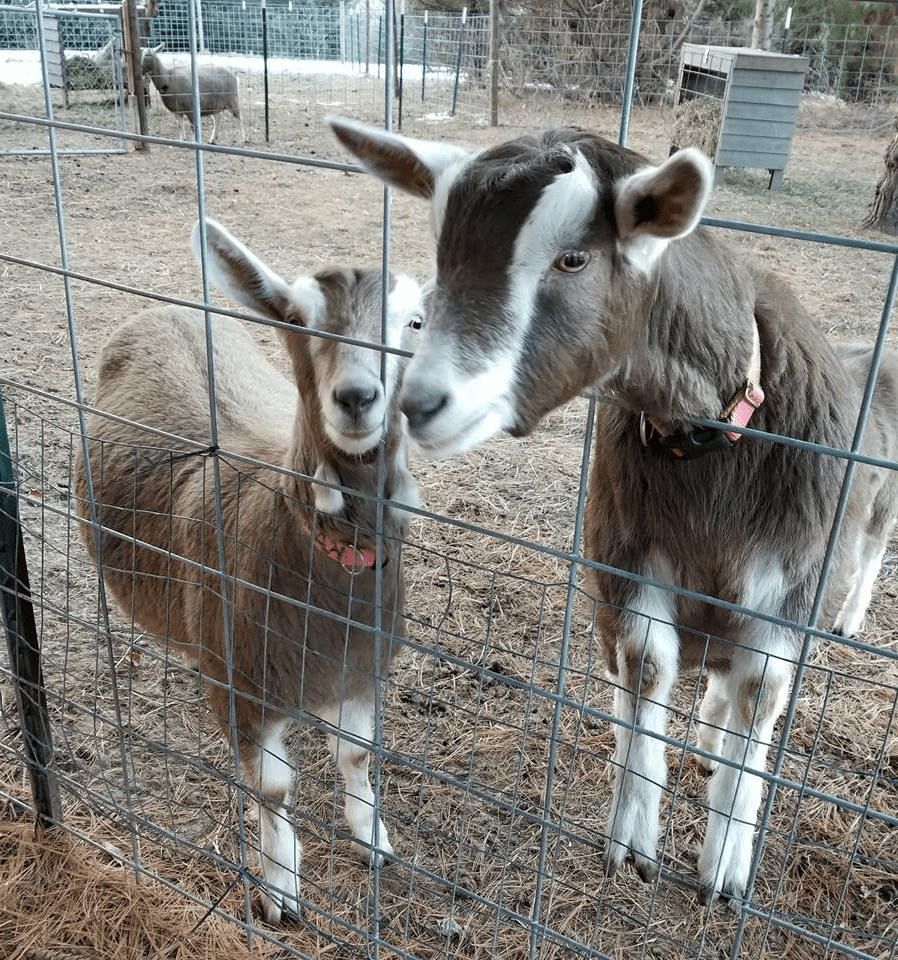The oldest known breed of goat, the Toggenburg goat, is generally raised to give milk. A smaller sized goat, these goats are a wonderful choice for the homesteader because they require less feed than some other breeds of dairy goats. You can also use them for meat, but this isn’t their primary purpose.
These dairy goats are also very hardy, particularly in cooler climates. If you are interested in a moderately producing milk goat, the Toggenburg may be just the one for your homestead.
Toggenburg Goat Breed History
The Toggenburg breed originated in Switzerland in the Toggenburg Valley, where their name originated. They came from crossbreeding local, brown colored goats with white Appenzell and bay-black goats from neighboring villages. Breeders wished to create a breed that had a distinctive appearance unique to their locality.
Because the breed was productive, hardy, and good-natured, it spread throughout Europe. Eventually, the breed was exported to Great Britain in the 1700s, and the United States in the 1800s.
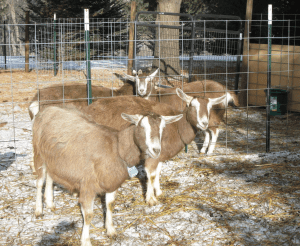
Breed Characteristics and Appearance
Toggenburg goats are medium-sized goats, with males weighing between 150 and 200 pounds and females weighing between 110 and 125 pounds. The female goats are usually 30 to 32 inches tall. Males grow to about 34 to 38 inches in height.
Generally, Toggenburg goats are bearded goats with solid colored bodies that can range from light brown to dark brown. They have white lines extending down the length of the face over each eye to the tip of the muzzle. Their bodies will have varying white markings.
Usually, they have white colored ears with a dark spot in the middle of the ears. Toggenburg goats have white legs. They also have short tails with a triangle of white on either side of the tail.
Some Toggenburg goats have horns, but most do not. When the horns are present they are erect and tall. These goats can be fiesty, so learning about goat horns is important if your Toggs grow horns.
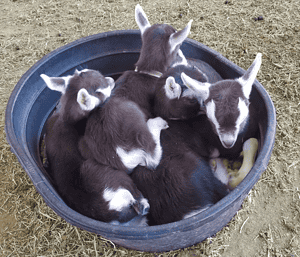
What is the Toggenburg Goat Used For
As far as the purpose for raising, Toggenburgs are generally used as dairy goats. Toggenburg goat milk is low in butterfat. It is good for drinking but not so good if your main interest is cheesemaking or making butter. They give a decent amount of milk, so from this aspect, they are considered a good dairy breed if you want milk to drink or to sell. However, they will not be the best choice if you want to start a cheesemaking business.
Toggenburg goats are not only good for dairy. Their wethers (castrated males) also make decent meat. You may also want to cull does that are low milk producers. You many also want to choose bucks for meat if they don’t reinforce the doe’s strong genetic points and if they share any of her major genetic flaws.
However, overall, Toggenburgs are considered to be more of a dairy goat rather than a meat goat. What is a wether goat
Sometimes people will cross a Toggenburg goat to a traditional meat breed of goat, like a Boer goat. The males of resulting offspring are well muscled and make for a good meal carcass. The females of these crosses will be excellent milkers while giving birth to kids that make good meat animals. These cross-breeds are excellent dual-purpose animals.
Because Toggenburgs are friendly and inquisitive, they are sometimes used as pets. However, intact buck goats should not be used as pets. As these male goats grow older, they may become dangerous to handle.
Other milk goats to consider raising are the Alpine goat, Nubian goats, and Nigerian dwarf goats.
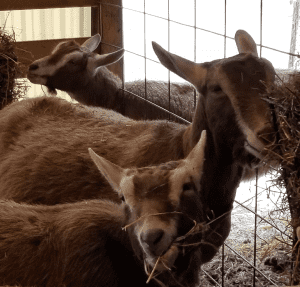
Feeding Toggenburg Goats
All goats will eat grass, but they also love to browse. This means that they enjoy nibbling on woody bits of shrubs, the bark of trees, thorns, and brambles. These animals will even eat thistles and poison ivy. If you have fields that are partially shaded or brushy, that is ideal grazing for your goats.
In summer, about a half acre per goat should be sufficient pasture for your goats. It is best if this pasture has a mix of grasses, weeds, shrubs, briers, and trees. Be sure to rotate pasture.
Adult Toggenburg goats need 2 to 4 pounds of hay per day in winter. If your female Toggenburgs are in milk, they may need up to 7 pounds of hay per day. The amount eaten may increase a bit during severe winter weather, since it takes more feed to stay warm.
Goats can be incredibly picky about their hay. If it is stepped on or laid upon, they probably won’t eat it, so be sure to mount a hay rack to keep the hay off the ground and minimize wastage.
Toggenburg goats also need a mineral block to provide essential vitamins and minerals. Be sure that your goat block includes copper because goats do need this essential element.
Provide free access to water in all sorts of weather. In summer, your Toggenburgs will need free access to all the cool water that they want. Make sure that the water is clean, because parasites can be transmitted by foul water. In winter, check their water several times a day to ensure that it is not frozen.
When your Toggenburgs are in milk, does should get about one pound of a 14% to 16% grain supplement for every gallon of milk that she produces. When your goats are a few weeks from kidding, start slowly introducing the grain that she will need. Never suddenly increase a grain ration, because this can upset your goat’s stomach.
Buck Toggenburg goats, kids, and dry does only need a handful or two of grain each day as a treat. Most of their nutrition should come from grazing and browsing. What do goats eat.
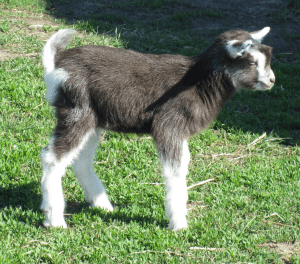
Breeding Toggenburg Goats
One Toggenburg buck can breed about 25 to 35 does. He will reach sexual maturity around 4 to 8 months of age. Be sure that you keep your young bucks separate from your does because he may breed them before they are ready.
While Toggenburg dairy goat females may start cycling at 7 to 10 months of age, she may not necessarily be ready to be a mother that early. You should wait until she weighs about 75 pounds before you put her in with the buck.
Does will be in heat for 2 to 25 hours. This is when she is ovulating and ready to be bred. Generally, her cycle is about 21 days long.
Toggenburgs have a pregnancy that is a bit longer than many other goat breeds. Many goats are pregnant for 150 days, but Toggenburgs can go as long as 179 days before having their kids. How long are goats pregnant
Twins are common for Toggenburg dairy goats, especially for mothers who have had at least one prior pregnancy. However, sometimes they will have three or even four babies at once. Take care of your kids, and learn when can baby goats go outside so they are safe from the weather, etc.
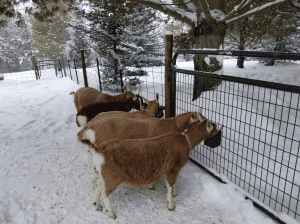
Milking and Milking Procedures
Toggenburg does are smart and easily trained. However, you should not wait to try to train a doe in the manners of milking until she has had her first kid. Most people prefer milking their does on a stand, to keep from stooping so low to milk. For Toggenburgs, since they are a smaller breed, milking on a stand is much more important.
Several weeks before you expect your kids to be born, get your goats in the habit of jumping up on the stand for a snack. As she stands there eating grain, brush the doe, touch her all over, and handle her teats. If you can get the does to do this first thing in the morning and in the evening, mimicking your milking rhythm, that is ideal.
After the doe has her kids, her first milk is colostrum, a rich, yellow colored milk. This milk is loaded with nourishment and antibodies for the kids. Feed as much of this to the babies as they will take.
After several days, the Toggenburg doe’s milk will come in. Now she can be milked. If you want to take the babies away and bottle-feed them, you can do so. However, if you want to practice “share milking” you will simply separate the babies from their mother overnight. Next morning, milk the doe and then turn her out with her kids. The kids will get the daytime milk, and you will get the milk that accumulates in her udder over the night hours.
You can milk by machine or by hand. Brush her before milking to prevent loose hairs from falling into the milk. Clean the teats with a wet cloth before milking too. If you use a machine, keep it scrupulously clean, scrubbing it with dairy soap after each milking. Everything that you use for milk should be pristine, from the rags used for cleaning, to milk buckets, and the strainer that you use.
After milking, strain the milk to remove any specks of dust or stray hairs. You should refrigerate the milk immediately and use it within three days if you consume it raw. If you pasteurize the milk by heating it to 165 degrees for 15 to 30 seconds, it will stay fresh for about a week. Every jar of milk should be labeled with a date.
Toggenburg goat milk is lower in butterfat than some other breed’s milk. For this reason, many people only use Toggenburg milk for drinking, rather than for making cheese or butter. A Toggenburg at peak production will make about a gallon of milk per day.
Lifespan
A Toggenburg goat lifespan is between 8 and 12 years, like Alpine goats. They will be productive for almost all of that time. To compare this with how long goats live from other milk breeds, consider the Alpine lives around the same amount of time as Toggenburgs while Nigerian Dwarfs can live around 15 years with proper care.
Caring for Toggenburg Goats
Toggenburg goats need food, water, shelter, and proper fencing for pigs to keep them secure on your property. Make sure that their food and water stay clean to keep the animals healthy.
In summer, Toggenburgs need shade from the sun. In winter, they will need shelter from the elements. If you have a barn or shed where the goats can get out of the weather, be sure that it still has good air circulation. They will need about 12 square feet of space per goat.
Parasites are always a concern for those who raise small livestock. Rotational grazing, where the herd is moved to a new paddock every 4 to 6 days can break up parasite life cycles. Try to keep the goats off of each paddock for at least 60 days to prevent reinfection of parasites.
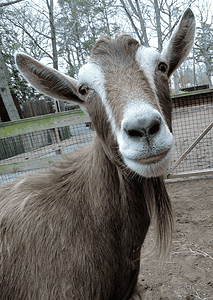
Check your goats for parasites using the FAMACHA scale, which your veterinarian can explain to you. When your goats do have parasites, worm them according to their weight. Do not unnecessarily worm your goats because this can lead to parasite resistance to the most common worming medicines.
Pros and Cons of Raising Toggenburg Dairy Goats
Toggenburgs do best in climates that mirror the place in which they originated. Meaning, that they do very well in cooler climates. If you live in an area with cold winters, a Toggenburg goat might be the best choice for your homestead. However, if you live in a place with long hot summers, another breed might be better suited for your operation.
A drawback of the Toggenburg breed is that they are very active animals. They will test your fences, so make sure your fences are good and tight before turning your new herd of goats into the pasture.
Toggenburgs can have an ornery streak. These goats need bold, assertive owners who will not allow them to get too pushy. However, this cantankerous streak can be a benefit if you have animals like coyotes and dogs who might hassle the flock. The Toggenburg goat is sassy enough to take on a coyote and win.
Consider the reason you want to raise goats. If you are raising goats for profit, their milk is low in butterfat. In addition to providing milk for your family, you can sell the milk as well as make lotion, goat milk fudge, and more. They eat less feed than some other dairy goat breeds, making them have a decent ROI.
Just be aware the Toggenburg does are not prolific milk producers. This will be easier to handle for some goat owners and especially new dairy goat owners. Therefore them producing less milk than other goat breeds can be considered a pro or a con.
Learn about other goat breeds you may want to consider raising, including Kiko goats and Pygmy goats.
Toggenburg goats, along with other goat breeds, are among the best farm animals to raise. They are productive, providing milk and meat. Difference between sheep and goats

